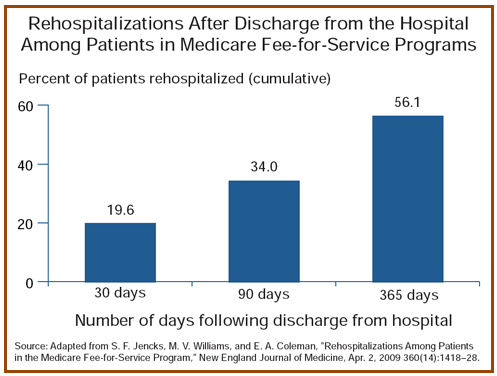Austin and the blog commenters have developed great advice for the super committee in tackling Medicare reform. And Austin’s follow up memo shows that he is realistic, but we have got to at least lay out the better way ahead. In that spirit, one of the suggested targets is focusing on the subset of patients with very high use and cost. This is often due to hospital readmission. A 2009 NEJM study by Jenks et al. demonstrates the magnitude of the problem:
Once admitted to a hospital, around 1 in 5 Medicare beneficiaries are readmitted within one month, and a third within 90 days. The goal of Medicare policy should be to pay for productive care for beneficiaries, which I would define as care that improves the patients’ quality of life and/or increases their lifespan. Readmissions could fit this definition, but many do not, and decreasing 30 day readmissions is viewed as a high priority since such a quick return visit to the hospital is likely to signal some problem in the follow up care available to Medicare beneficiaries.
CMS created the Community Based Care Transitions Project in April 2011 to seek proposals to test and adapt innovative models to reduce 30 day readmissions. Most importantly, the demonstrations are supposed to test and develop funding mechanisms that will encourage the reduction of hospital readmissions. This is the most important part of the demonstration, developing payment approaches that incentivize high quality care; if it reduces readmissions, then it is likely to also reduce cost. There are a variety of groups around the nation that have been focusing on this issue such as Boston University, and the University of Colorado at Denver. The key task is moving such pockets of excellence that are often being cross subsidized by other parts of academic medical systems into more widespread use. Can the best practices be widely implemented in a sustainable fashion?
There is a great deal of inertia to overcome in Medicare policy. Providers often exist in their silos, and have had to learn to exist within the current funding mechanisms. The new flurry of investigation initiated by the ACA is causing some dislocation of the silos, which is the point. For example, in the discussion of readmissions, many hospice and palliative medicine providers believe they have been doing the bread and butter work needed to avoid readmissions: understanding patient goals, discharge planning that accounts for the social context of the patient, and focusing on the needs of the caregiver and broader family. However, they are definitely a silo in the system for many reasons.
The hospice benefit in the Medicare program pays a straight per diem rate, just about the only per diem health care reimbursement mechanism that remains in Medicare (I can’t think of another; anyone else?). This has meant that hospice providers could carve out a niche and so long as they can survive (or thrive) on the per diem payment and their patient mix, they could function in many ways independently. And hospice has proven popular with patients, with over 40% of Medicare decedents using some hospice. Now that the overall health care system is looking closely at readmissions, hospice and palliative medicine providers need to join in and share their expertise at delivering care to try and integrate this experience throughout the health care system….it needs to move out of their silo.
The super committee will be looking for $1.2 Trillion in deficit reduction over 10 years. If all they do is shave payment rates, they will be missing the boat. We need changes in our health system not only in the next decade for a CBO score, but in the out years 11-40 when deficits absent profound health reform become truly unimaginable.Profound change will mean less care delivered per capita and better quality. This will be very hard, and nearly impossible so long as health reform is a political football.
Somehow we have got to produce a policy regime going forward that allows for the experimentation and development of new models of care and payment that are at least somewhat depoliticized. If this transitions project fails to identify a workable payment scheme to reduce readmissions, that doesn’t prove that the ACA was a failure. It just means we have more work to do to develop better models to prevent readmission.
Somehow, we need to get to a way forward in health reform that allows and requires experimentation, but doesn’t make every new finding first and foremost the next bullet in an ongoing political war between Democrats and Republicans. I am not optimistic, but remain hopeful.
update: Brad Flansbaum has a nice post on readmission prevention from a few days back. He is correct that ‘fixing’ readmission won’t magically fix the overall system. There is nothing but hard work to be done on the way to a sustainable health care system. And here is a paper I haven’t read carefully that Brad identifies asking if readmission policy exacerbates inequalities. Quick glance notes paper is saying that there are community/social factors that lead to readmissions….this is one of the things that hospice folks would claim to be good at addressing. I may write more on this later.


